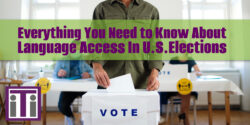Welcome to our “Basic Breakdown” series where we share all our insider knowledge on the types of language services and solutions possible for a variety of industries. Our goal is to help alleviate confusion between the many options offered by language service companies to help arm you with the knowledge YOU need to make the best decisions for your organization.
Today’s breakdown features CART services in education, or utilizing real-time translation in the classroom to enable your deaf or hard-of-hearing students’ learning capabilities.

We’ve previously discussed the importance of translation in the classroom for diverse multinational or ESL students in How To Create An All-Inclusive Education Environment, but what about the other students who may require translation services?
The Americans with Disabilities Act (ADA) mandates “auxiliary aids and services” to ensure effective communication with people who are deaf or hard of hearing. “Auxiliary aids and services” includes Communication Access Real-time Translation (CART). CART enhances the deaf and the hard of hearing’s ability to communicate and succeed in society, which begins in schools.
What is CART?
CART (Communication Access Real-time Translation) is when a stenotype machine, notebook computer and real-time software instantly translates spoken language into text which can be displayed on a display system such as a computer/cellphone monitor, projected onto a screen, or written out as video captions.
CART writers, highly trained professionals operating the CART system, position themselves so they can clearly hear the speaker(s) while watching the transcription they produce in order to correct mistakes and ensure high-quality transcribing.
CART vs C-Print: What’s the Difference?
An alternative to CART is C-Print. Both are alternative communication services; the difference is in their delivery.
CART transcribes every spoken word verbatim, including false starts, filler phrases such as “Um”, or any other small detail. A CART writer can sit in the physical classroom or listen in remotely via Voice Over Internet (VOIP). The interpreted text appears on the user’s screen.
C-Print is also speech-to-text technology, but a trained operator will produce a text display of the spoken word in a grammatically correct way, omitting filler phrases, false starts, etc. C-Print summarizes the conversation or lecture, writing out a condensed version of what was said, highlighting the most important points.
Read up more about CART and C-Print’s differences and benefits here.

How are alternative communication services like CART or C-Print beneficial to schools?
As a school striving to achieve an all-inclusive education, all students’ basic needs for education should be met. Deaf or hard-of-hearing students often struggle not because they can’t keep up with comprehending the material, but because classroom communication is largely verbal. They may miss key information that was said but not written on the board, or which was said too quickly, etc.
Hearing-impaired students often must concentrate on which words are being said in the classroom versus the context of what is being said. CART and C-Print do the transcription work for these students, allowing them to concentrate on learning.
According to the University of Washington, CART “enhance(s) students’ ability to learn in a classroom setting and communicate with instructors, mentors, and peers. Its accuracy, speed and the ability to use it in a wide variety of practical applications allows CART to enable students to follow dialogue efficiently and precisely.”
In classes that use more challenging vocabulary or technical terms, CART users can see the exact words being said and ask about them or look them up as needed. Students are not losing vocabulary that is hard to interpret. CART transcripts can also be saved and sent to students for studying purposes.
Students can benefit from Onsite CART, or Remote CART where the writer is in a different location but transcribes by listening through a VOIP connection. Remote CART allows users to be mobile, allowing them to engage in life situations that might otherwise be challenging, such as excursions or campus tours.

Why are CART services important?
CART and C-Print help lessen the disadvantage deaf or hearing-impaired students have in the classroom. With these services, students can:
- Improve their comprehension of classroom lessons
- Take better notes
- Ask questions faster
- Participate more
- Review precise notes
Beyond this, as we touched on in our article Benefits of Interpreter Services in Education, CART and C-Print can also improve and serve as live subtitles for large lectures, live discussions, presentations, or ceremonies such as graduation for hearing-impaired students!
Students become able to participate more and hence gain a higher quality education experience, in and outside of the classroom. These services also allow the school to recognize and nurture the unique strengths of their hearing-impaired students.
How do I request CART or C-Print services?
Whether you would like more information or are ready to find out how to incorporate CART or C-Print into your school system, please contact us and we’re happy to help.
This blog was updated on 9/28/2021






Comments are closed here.